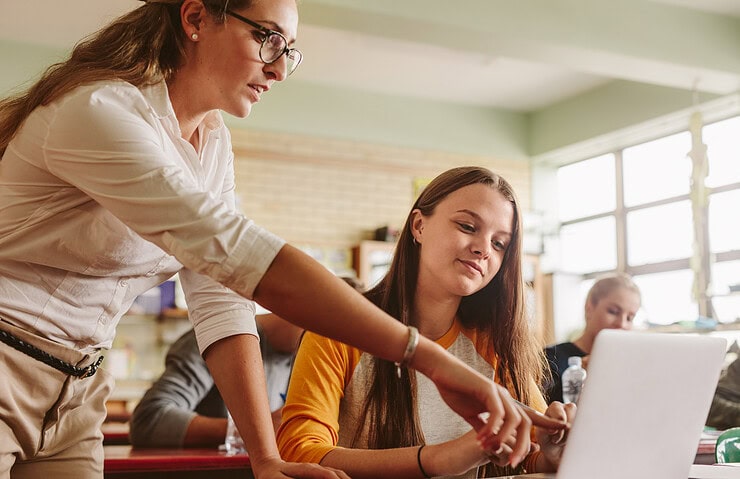Can personalized learning increase educational equity?
If not implemented well, personalized learning technologies risk harming the most disadvantaged students

Hanna Dumont was in her last year of high school when the results of the first PISA study were published. PISA – the Programme for International Student Assessment – tests 15-year-olds around the world in mathematics, reading, and science. The results that year inspired her to go on to research achievement inequality. Hanna tells Annie Brookman-Byrne about her recent work asking whether personalized learning can increase educational equity and exploring the consequences for students when it is not implemented well.
Annie Brookman-Byrne: What first inspired you to research achievement inequality?
Hanna Dumont: I was inspired by the results of the first PISA study. That study, conducted in 2001 when I was a high school student, showed that my home country of Germany had the largest gap of any OECD country in the achievement of students from disadvantaged and advantaged homes. We studied these results in one of my classes, and I found them shocking. I decided that I wanted to pursue a career in educational research, focusing on the causes and consequences of educational inequality. I was particularly interested in how personalized learning might be used to address the diverse needs of students in the classroom by providing more individualized educational opportunities. These are the questions that still motivate my research today.
ABB: What is personalized learning, and does it have the potential to address individual needs and reduce inequality?
HD: Personalized learning is an approach that adapts instruction to accommodate students’ individual differences. With technological advances increasing the availability and use of technological solutions for personalized learning, it is essential to assess both the potential and the risks of these technologies. In a recent theoretical paper, Douglas D. Ready and I discuss whether and under which conditions personalized learning can increase equity in education. We bring together insights from different fields, including the learning sciences, philosophy, psychology, and sociology.
“Personalized learning has great potential to promote equity because it takes into account the fact that learning is a highly individual process.”
On the one hand, personalized learning has great potential to promote equity because it takes into account the fact that learning is a highly individual process, and that instruction is most effective when it meets students’ individual needs. When content is too advanced, there is a risk of “cognitive overload” – and as a result, students may fail to acquire new knowledge or learn it on only a very superficial level. Learning can also suffer if content is too easy. The targeted instruction provided through personalized learning should stimulate every student equally, resulting in learning gains for all students.
On the other hand, there are a number of risks when implementing personalized learning. When teachers employ personalized learning technologies, they may conclude that they themselves are no longer needed in the classroom. However, interaction with teachers and the socio-emotional support they provide to students is absolutely vital, particularly for low-achieving students. Learning is a highly social process, and engaging with others at school is critically important for students. Moreover, personalized learning technologies often require students to have strong self-regulation skills, which many students have not yet developed. Without those skills, students may not be capable of engaging in learning because they are unable to stay on task or monitor their own learning. Teachers therefore play a key role in implementing personalized learning effectively.
“Learning is a highly social process, and engaging with others at school is critically important for students.”
Finally, we argue that personalized learning may not lead to equality in outcomes, and may even increase achievement inequalities, because high-ability students tend to learn faster than low-ability students. However, in our view, this is not problematic as long as all students develop the necessary skills to fully participate in society as active members.
ABB: What do teachers need to know before using personalized approaches to improve children’s learning?
HD: Numerous school systems around the world have already implemented personalized learning in the classroom, in the belief that providing students with unique learning experiences improves the outcomes of all children. Yet it is important to remember that personalized learning comes with certain risks when not implemented well, and may even harm students, especially those from disadvantaged backgrounds. Given the crucial role teachers continue to play in students’ learning, it is essential to integrate new personalized learning technologies into teachers’ overall classroom instruction.
Footnotes
Hanna Dumont is a Professor in the Department of Educational Sciences, University of Potsdam, Germany. She holds a PhD in Educational Psychology and is interested in the processes in families and schools that lead to differences in students’ cognitive and motivational development as a function of social background. In her work, she aims to bridge the gap between research, policy and practice. Hanna Dumont was a Jacobs Early Career Research Fellow 2016-2018.
Hanna Dumont contributed to a special collection on understanding and addressing inequality in education in the journal npj Science of Learning. This interview is part of a series dedicated to sharing practical takeaways and personal insights from authors.
The interview has been edited for clarity.


